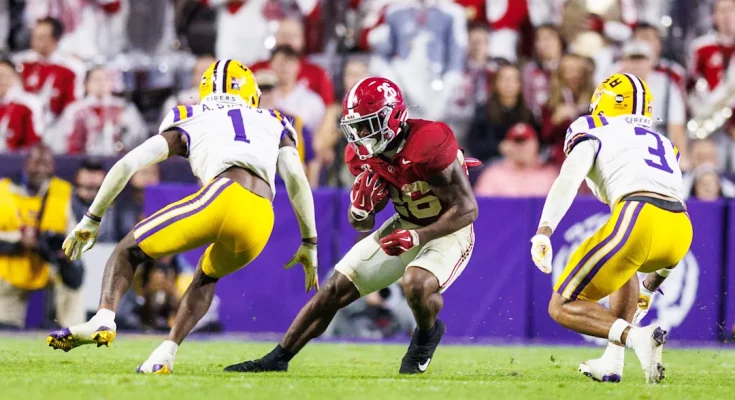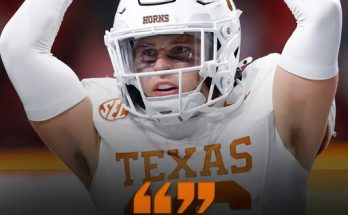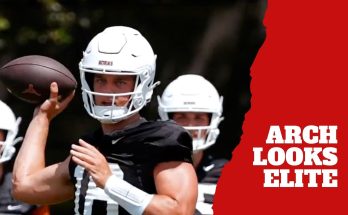The news of a star running back going down with a significant injury during fall camp has sent shockwaves throughout the college football landscape, especially in the SEC, where every piece of personnel news can tilt the balance of power. The headline “Devastating Camp Setback: SEC Powerhouse and Fierce LSU Rival Loses Star Running Back to Injury, Shaking Up Conference Title Race” isn’t just an attention grabber; it captures the exact weight of this moment. When a premier program in the Southeastern Conference—one that has regularly battled LSU for divisional supremacy—loses its most dangerous offensive weapon before the season even kicks off, the ripple effects are enormous. The SEC is unforgiving, and one player’s injury, especially at such a crucial skill position, can alter the outcome of an entire season, shift betting odds, and even reshape the College Football Playoff race.
Running backs in the SEC carry an outsized legacy. From Herschel Walker to Bo Jackson, Leonard Fournette to Derrick Henry, the position has been a defining feature of the conference’s identity for decades. Fans, coaches, and players alike recognize that having an elite running back is not just an offensive luxury but a cultural staple of what it means to compete in this league. So, when a powerhouse rival of LSU suddenly loses a top-tier back during camp, the implications go far beyond filling a depth chart. It challenges a coaching staff’s adaptability, tests the resilience of an offensive line, and places new pressure on a quarterback who may have been counting on a balanced attack to thrive.
The timing of this injury makes the blow even more devastating. Fall camp is the bridge between offseason speculation and on-field execution. It’s the period when playbooks are refined, chemistry is developed, and depth charts start to solidify. A setback now doesn’t just mean the player is unavailable for a few weeks—it often means that entire offensive philosophies may need to be reconsidered before Week 1. This is especially true in the SEC, where a team’s first few games can include neutral-site showcases or crucial conference matchups that immediately shape the postseason trajectory. For LSU, watching a rival lose such a crucial piece of its offense inevitably changes how Brian Kelly and his staff prepare. Defensive coordinators will now look at ways to exploit the absence, anticipating a heavier reliance on the passing game or perhaps a reshuffled running back rotation that lacks the same explosiveness.
For the rival team itself, the questions pile up quickly. Can the backups shoulder the load? Is there a veteran presence in the locker room who can stabilize morale? Will the offensive coordinator pivot to a more pass-heavy approach, or will they double down on the next man up mentality, hoping the offensive line can mask the absence? In college football, star players aren’t easily replaced, especially when the injured player was projected to be a central figure in Heisman discussions or All-SEC honors. The reality is that recruiting rankings and depth charts may look strong on paper, but true game-changing talent is rare. Losing a player who was expected to carry 20 to 25 touches per game not only reduces offensive output but also places greater wear and tear on the rest of the roster.
Fans of LSU and across the SEC will immediately begin speculating on how this injury reshapes the season. Rivalries in this conference are fueled by parity and unpredictability, and LSU knows better than most how one injury can shift everything. Just as LSU has had seasons derailed by key players missing time, their rival now faces a similar challenge. Media narratives will quickly shift to whether this makes LSU the new frontrunner in the division or whether it opens the door for another contender, perhaps Alabama, Texas A&M, or Ole Miss, to stake their claim.
Injuries also have a psychological impact beyond the X’s and O’s. A locker room can either rally around the loss of a star, adopting an underdog mentality, or it can falter under the weight of expectations suddenly thrown into jeopardy. Coaches in these moments are tasked not only with adjusting game plans but with managing emotions, keeping players focused, and reminding the team that championships are won through collective effort, not just individual brilliance. This is where leadership becomes critical—both from the coaching staff and from captains on the field. The narrative of “next man up” has been romanticized in sports, but in the SEC, the next man up often finds himself facing elite defensive fronts, hostile stadiums, and immense pressure under the national spotlight.
From a broader SEC perspective, this injury could have cascading effects on the conference race. The College Football Playoff committee has made it clear in the past that quality wins in the SEC matter more than almost any other metric. If this powerhouse rival begins the season slowly because of its offensive struggles, it could open opportunities for other programs to gain statement wins and improve their playoff resumes. Conversely, if the rival manages to overcome the setback and still contend, the story could evolve into one of resilience and coaching brilliance—a narrative that often captures national attention and bolsters playoff arguments.
The media attention surrounding such an injury will also affect the player himself. College athletes are under immense scrutiny, and for a star running back to have his season derailed before it begins is heartbreaking. Fans and teammates will rally, but the personal toll of watching games from the sideline, seeing others take reps, and hearing constant speculation about what could have been is often overlooked. Rehabilitation is as much a mental challenge as a physical one. For the player, the focus will shift toward recovery, preserving NFL Draft stock, and proving that this setback is just a temporary chapter in an otherwise promising career. In today’s NIL-driven era, injuries also raise questions about endorsements, future earnings, and professional trajectories. For someone expected to carry the team, this loss is measured not just in wins and losses but in long-term personal impact.
From LSU’s vantage point, the injury creates both opportunity and responsibility. It’s natural for fans to feel a surge of optimism knowing a rival has been weakened. Yet Brian Kelly will likely caution his team against complacency. Injuries can level the playing field, but they can also galvanize an opponent, making them even more dangerous. Preparing as if the star running back were still on the field is the disciplined approach that LSU’s staff will emphasize. That said, defensive coordinators will certainly adjust their schemes, perhaps choosing to bring more pressure on the quarterback or daring the replacement backs to prove they can handle SEC defenses.
Recruiting battles could also be influenced. Young recruits watching the season unfold will pay attention to how teams respond to adversity. If LSU handles the new landscape with poise and capitalizes on the opportunity, it reinforces the perception of the program as one that is steady, opportunistic, and championship-minded. Conversely, if the rival team collapses under the weight of the injury, it may affect future recruiting momentum, particularly for skill position players who want assurance that they’ll be supported by depth and strong offensive systems.
The SEC is often described as a gauntlet, where survival of the fittest is not just a cliché but a weekly reality. Injuries are part of the game, but when they strike a superstar, the conversation shifts from survival to reinvention. For this particular powerhouse, reinvention will define the season. Can the offensive coordinator script around the absence? Can special teams or defensive scoring compensate for reduced offensive firepower? Can the quarterback elevate his play to become the face of the offense? These are questions that fans, analysts, and rivals alike will watch closely as the season begins.
For college football as a whole, this moment underscores the volatility and drama that make the sport so compelling. One week, a team is a projected playoff contender with a Heisman-caliber running back leading the way. The next, their trajectory is completely altered by an injury in camp. This unpredictability is why fans remain glued to every update, why message boards buzz with speculation, and why coaches never allow themselves to look too far ahead. The margin between greatness and disappointment in college football is razor-thin, and often decided by moments like this.
As the dust settles from this shocking setback, one thing is certain: the SEC race has been shaken, and LSU’s path to contention has been impacted. The season ahead will test the mettle of coaches, the resolve of players, and the patience of fans. For the rival program, the absence of its star running back may define 2025 as a year of “what ifs,” or it may become the spark that drives an improbable run. Either way, this injury has already changed the SEC conversation before the first whistle of the season. And in the unforgiving world of college football, where every game feels like a playoff, that’s enough to make this one of the most significant developments of the year.



